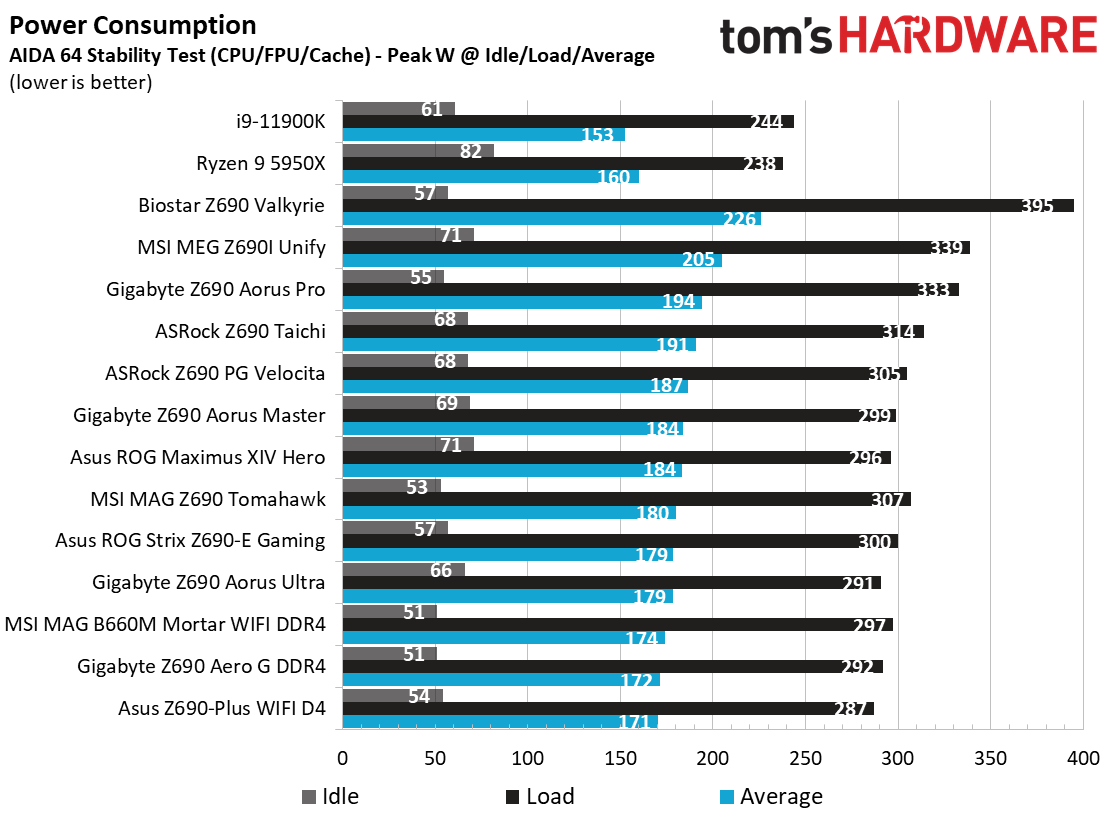Why you can trust Tom's Hardware
Our standard benchmarks and power tests are performed using the CPU’s stock frequencies (including any default boost/turbo), with all power-saving features enabled. We set optimized defaults in the BIOS and the memory by enabling the XMP profile. For this baseline testing, the Windows power scheme is set to balanced (default), so the PC idles appropriately.
To get the most out of the Intel Alder Lake chips, you need to be on Windows 11 with its updated scheduler. In most cases, Windows 10 performs well. However, some tests (Cinebench R20, Corona and POVRay) take a significant hit. In short, if you’re going with Alder Lake, you must upgrade to Windows 11 for the best results across the board. That may change with patching and updates in the future, though.
Synthetic Benchmarks
Synthetics provide a great way to determine how a board runs, as identical settings should produce similar performance results. Turbo boost wattage and advanced memory timings are places where motherboard makers can still optimize for either stability or performance, though, and those settings can impact some testing.



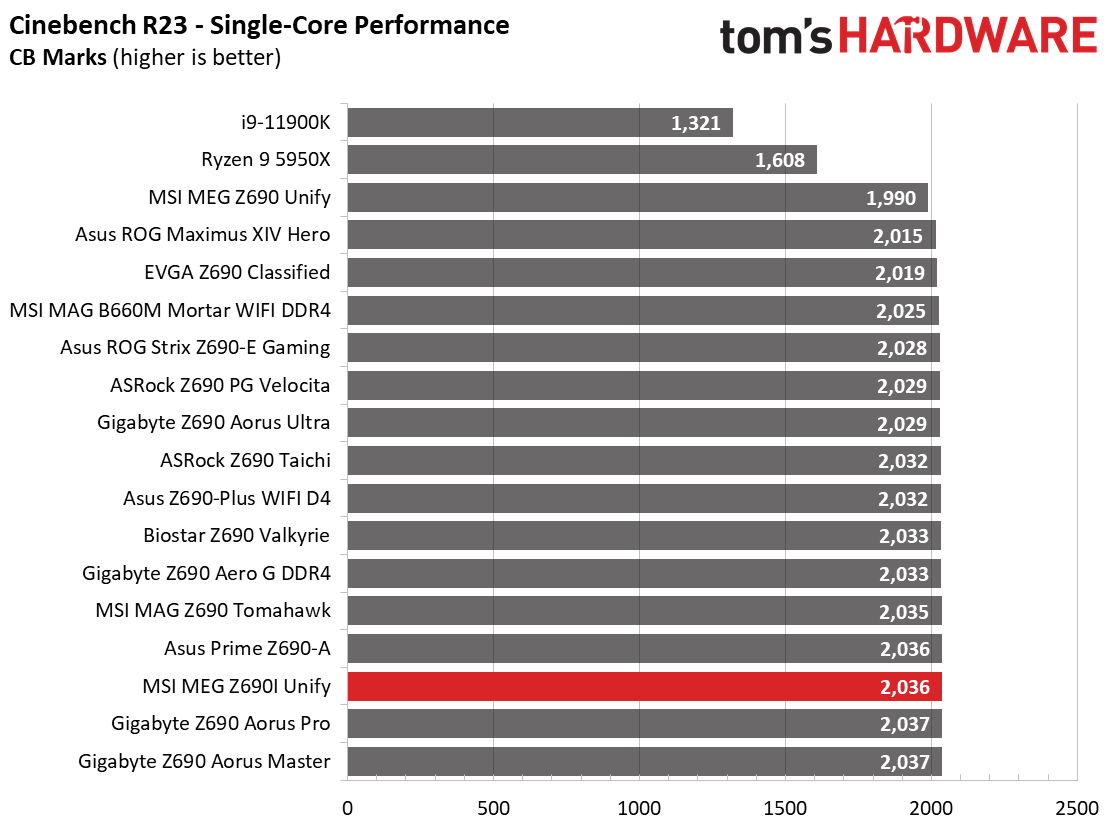









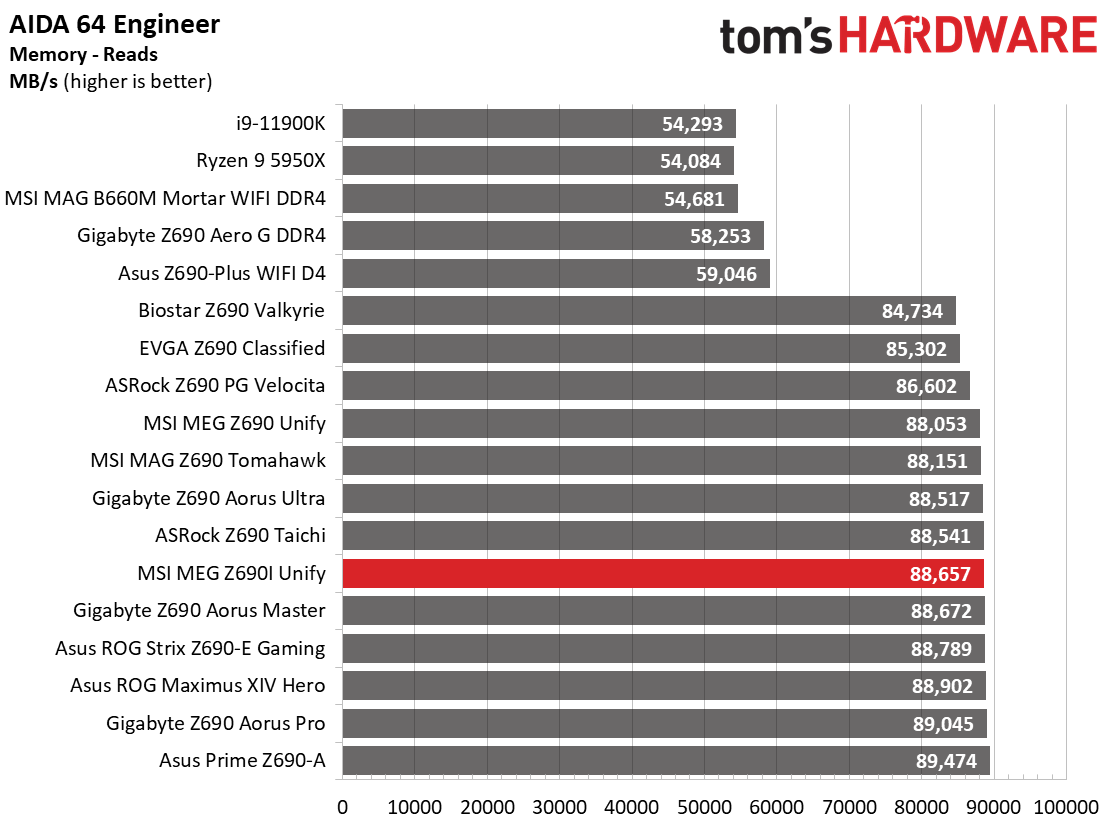


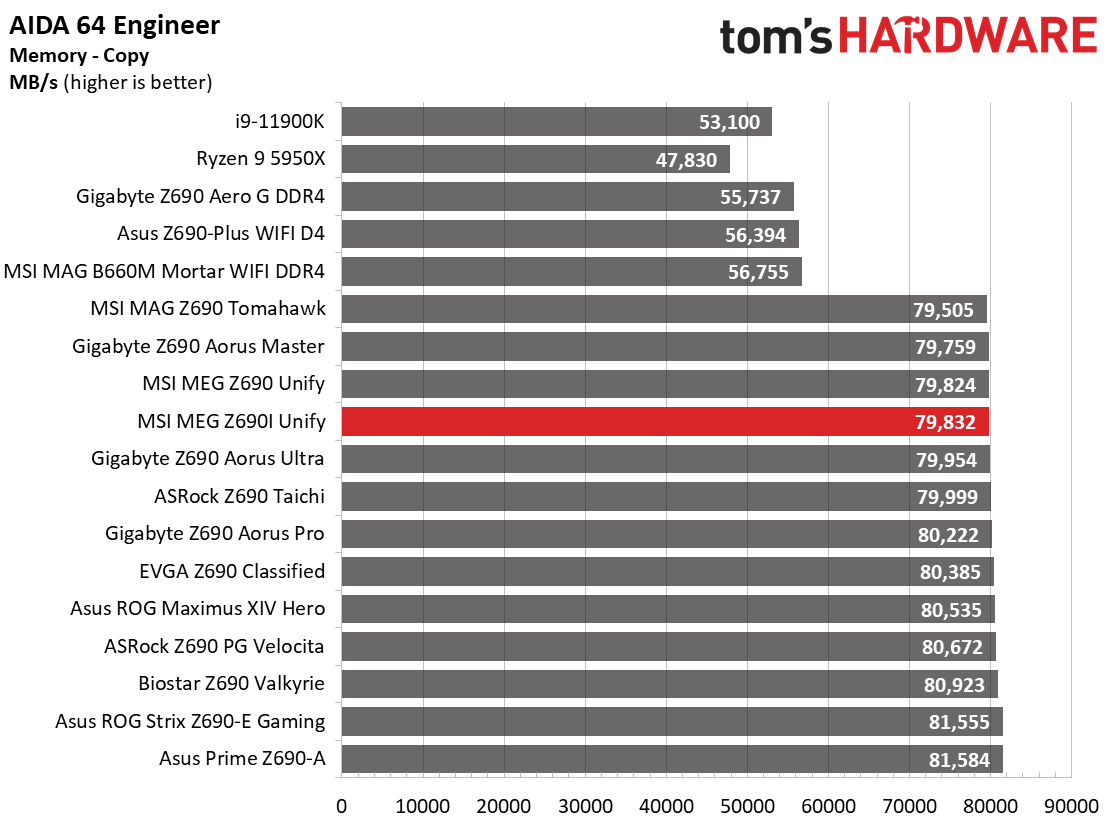
The Z690I Unify traded punches with the other boards we’ve tested so far. Like the previously-tested full-size Z690 Unify, it wasn’t the fastest or slowest in any benchmark.
Timed Applications


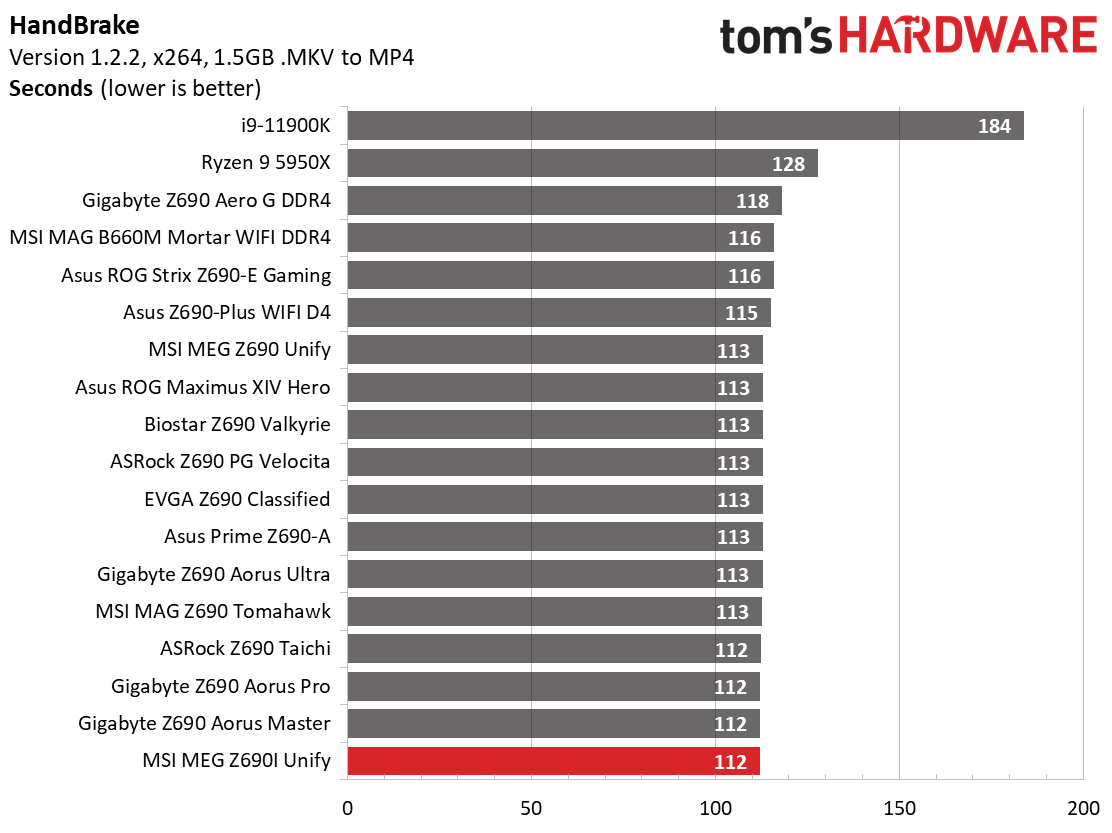

In these tests, Z690I Unify performed well overall. Starting with the LAME test, the little Unify put up the second-fastest time at 9.53 seconds. The Corona result was average at 52 seconds. Handbrake testing was a tale of two tests, with the Unify tying for the fastest result at 112 seconds in the x264 test, while it was one of the slowest performers in the x265 test, at 205 seconds.
3D Games and 3DMark

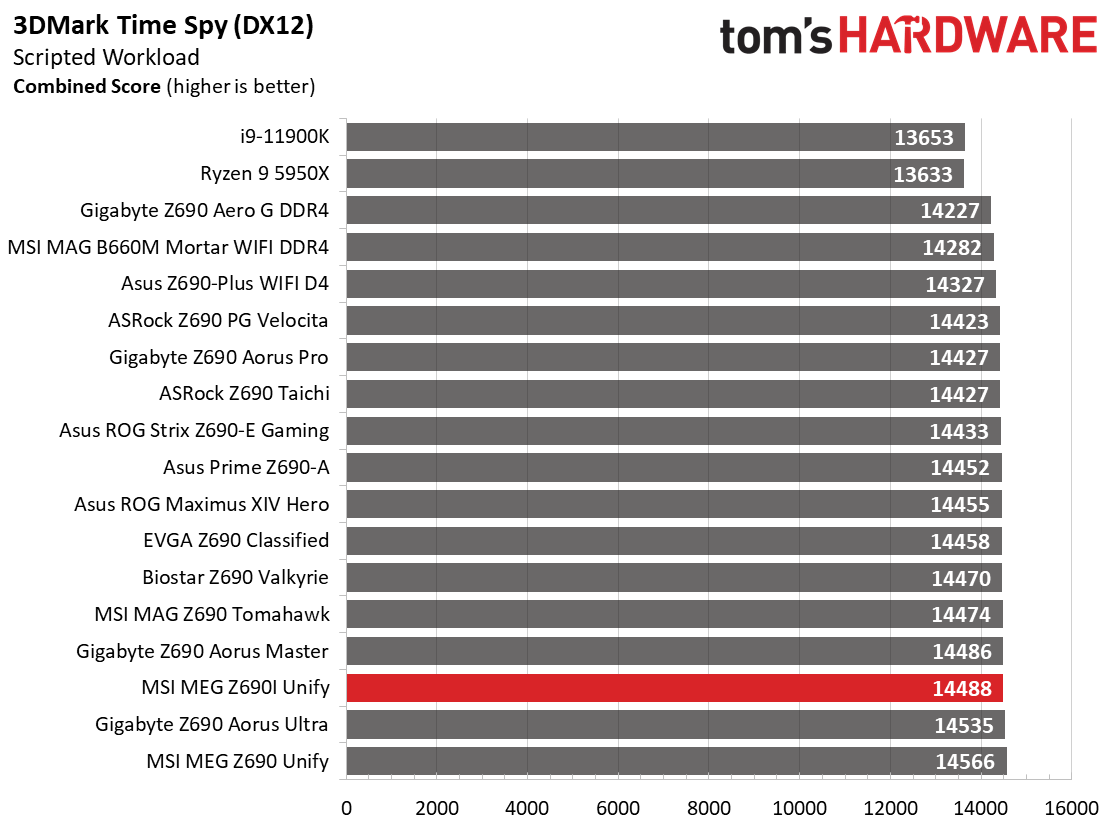


Starting with the launch of the Z690 chipset, we’ve updated our game tests. We’ve updated Far Cry: New Dawn to Far Cry 6 and shifted from F1 2020 to F1 2021. We run the games at 1920x1080 resolution using the Ultra preset (details listed above). As the resolution goes up, the CPU tends to have less impact. The goal with these settings is to determine if there are differences in performance at the most commonly used resolution with settings most people use or at least strive for. We expect the difference between boards in these tests to be minor, with most falling within the margin of error differences. We’ve also added a minimum FPS value, as that can affect your gameplay and immersion experience.
In F1 2021, the Z690I Unify achieved an average of 165 frames per second (fps), with minimums of 141 fps, both on the higher end of results so far. Far Cry 6 testing resulted in average results. In this case, the Unify averaged 137 fps, with a minimum of 123 fps.
Get Tom's Hardware's best news and in-depth reviews, straight to your inbox.
The synthetic benchmarks continue to show little more than a negligible difference between the fastest and slowest boards. Our Z690I Unify hit 14,488 on 3DMark Time Spy and 16,928 on Fire Strike Extreme, both on the higher side of average.
Power Consumption / VRM Temperatures
We used AIDA64’s System Stability Test with Stress CPU, FPU and Cache enabled for power testing, using the peak power consumption value. The wattage reading is from the wall via a Kill-A-Watt meter to capture the entire PC minus the monitor. The only variable that changes is the motherboard; all other parts are the same.
At idle, the Z690I Unify consumed 71W, which is on the higher side of our results. Load wattage peaked at 339W, the second-highest value we’ve recorded. Overall, the Unify is one of the more power-hungry boards we’ve tested. That said, it will be tough to see a difference in your electric bill, but the differences are there.


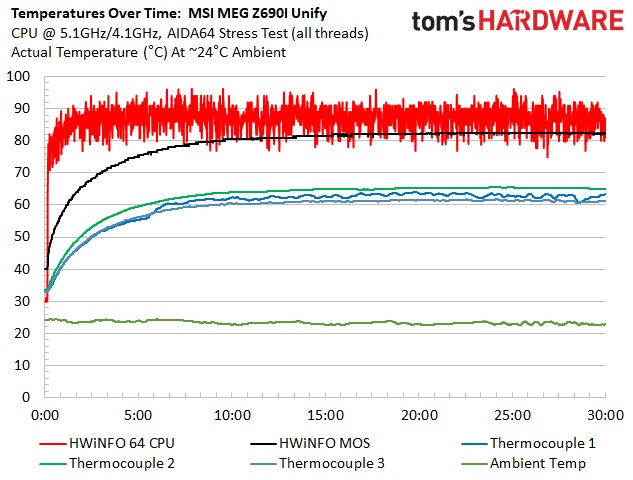

VRM temperatures were some of the highest we’ve seen on this platform, reaching over 60 degrees Celsius on our Extech device sensors and over 80 degrees on the internal sensor at stock speeds. In fact, we saw some form of thermal throttling of the CPU a couple of times. Once overclocked, temperatures on the VRM went up a bit, but we didn’t capture any throttling when using a static voltage. I would like to see these temperatures lower with active cooling, but they are still within specification. The tiny fan was active but inaudible, so the board wasn’t concerned either as the fan speeds didn’t seem to change at our peak temperatures.
Overclocking
Overclocking with Alder Lake is slightly different from what we’re used to due to the hybrid core configuration. Now, you can overclock the P and E cores separately, though they both use the same voltage domain. You can push one and not the other, or both, so there’s some flexibility. To that end, we set an overclock to 5.1 GHz across all P-cores and 4.1Ghz on all E-cores. This yields a 200 MHz bump on the P-cores and a 400 MHz increase on the E-cores. We’re topped out on the P-cores, primarily due to temperatures, but the more efficient E-cores still have some headroom.
Overclocking with Z689I Unify and the flagship 8+8-core/24-thread i9-12900K proved painless. Since we’ve found our required voltage with our first review, we plugged in that 1.25V value for Vcore, adjusted LLC to LLC4, and tested it successfully. According to CPUz, the voltage was 1.24V, so using LLC4 effectively mitigated the vdroop.
On the memory front, we set XMP and off we went with our GSkill Trident Z5 DDR5 5600 CL36 kit and the new, faster ADATA XPG DDR5 6000 kit. This yields an 800 and 1,200 MHz (respectively) increase from the maximum stock rating of the platform (DDR5 4800). We’re sure there’s more overclocking headroom available, but as always, your mileage may vary.
Bottom Line
After taking a look at the MSI MEG Z690I Unify, I walked away feeling good about this motherboard. Compared to other ITX offerings, It comes loaded with features including three M.2 sockets, four SATA ports, the latest-generation flagship audio, Thunderbolt 4 (40 Gbps Type-C) ports and integrated Wi-Fi 6E in this diminutive package. You get all of the above for $399.99, which is an increase of $30 over the Z590 version. In all, the small black motherboard packs a punch both with the hardware that comes with it and performance easily matching larger ATX boards overall.
The only hardware concern with the Z690I Unify is the number of Type-A ports on the rear IO. For some, the six available Type-A ports aren’t enough to cover all your peripherals and extras. There are still front panel connectors to help, but unlike larger motherboards, you don’t have the luxury of a free PCIe slot for an add-in-card. Outside of that, there isn’t too much to complain about that other ITX size boards don’t all contend with anyway (lack of additional PCIe slots/SATA ports, etc.).
There’s plenty of competition in the Mini-ITX space, as each major board partner has one for Z690. Asus hit the market with a ROG Strix Z690-I Gaming ($439.99), ASRock the Z690 Phantom Gaming-ITX/TB4 ($349.99), and Gigabyte has the Z690I Aorus Ultra ($309.99)s. If your needs are focused around storage, the Gigabyte with two M.2 sockets and two SATA ports is out, even at its notably lower price point. The ASRock is the only board in this group with the last generation Realtek audio codec, but few would notice a difference. All of these boards include capable power delivery and would easily power any Alder Lake processor. So the difference comes down to hardware requirements and price.
When choosing a Mini-ITX motherboard, it’s critical to ensure it has everything you need now and for the future, as expanding ports internally on this size motherboard just isn’t possible. The best you can do is add some kind of hub.
In the end, the MSI MEG Z690I Unify is a good choice in the ITX market. Although the price is high compared to most of its competition, it has the most features and connectivity users are likely to look for in a small form-factor board. Because of that, we feel the Z690I Unify is the best option for those looking to build a small but powerful Alder Lake rig.
MORE: Best Motherboards
MORE: How To Choose A Motherboard
MORE: All Motherboard Content

Joe Shields is a staff writer at Tom’s Hardware. He reviews motherboards and PC components.
-
g-unit1111 3 M2 sockets on a mini ITX? How does that thing not deep fry itself on the first use?Reply -
watzupken Reply
I feel 2 M2 SSD being cooled by a single heatsink is possible. The only problem is the one at the rear due to the lack of airflow. In my previous PC setup, the SSD can run quite hot, especially if you do not install a heatsink on it.g-unit1111 said:3 M2 sockets on a mini ITX? How does that thing not deep fry itself on the first use? -
potluck The review list 128GB max RAM in the specifications, while MSI gives 96GB max. Is it possible to use this board with 2x 64GB modules?Reply
There's also a fourth M.2 slot listed … :oops:
